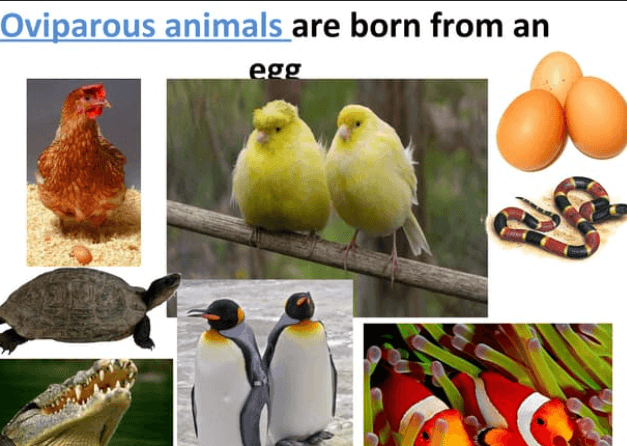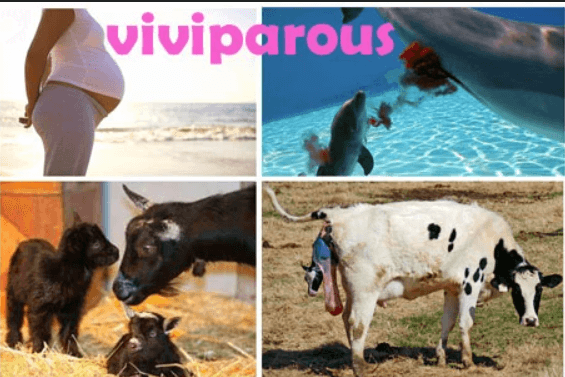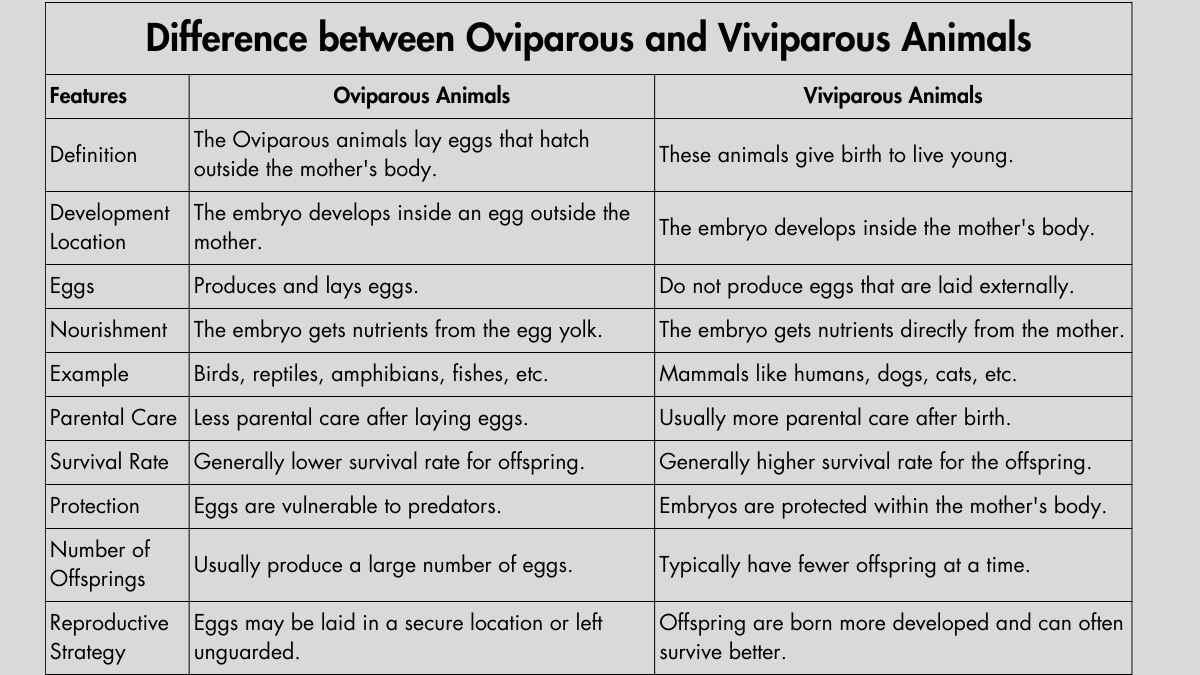As we know, there is a huge variety of animals present on the earth’s surface. Different animals have different ways of living, growing, and reproducing. Some animals, like birds, snakes, and frogs lay eggs, and are known as oviparous animals. While others, like humans, dogs, crows, and many other animals give birth to their young ones, known as viviparous. Some show the characteristics of both oviparous and viviparous animals, but none are strictly both. Each animal has its own way of taking care of their young ones. For more information regarding the Oviparous and Viviparous Animals, students must go through the complete article below.
Oviparous Animals
Oviparous Animals are animals that lay eggs. The young ones grow inside the eggs and hatch out when they are ready. Birds [accept bats], reptiles, fishes, and most insects are examples of oviparous animals. The eggs protect the baby animals and provide food while they develop. The mother usually lays eggs in a safe place, and sometimes the parents take care of them until they hatch. For example, a hen lays eggs and keeps them warm until the chicks are born.

Viviparous Animals
Animals that give birth to live young instead of laying eggs are called viviparous animals. These baby animals grow inside the mother’s body until they are ready to be born. Most mammals, like humans, dogs, cats, and crows, fall into this category. It is considered interesting that Platypus being a mammal is not a viviparous animal, while it lays eggs. In these animals, the developing embryos receive nourishment directly from the mother through a placenta, which allows for a long gestation period. This method of Reproduction helps ensure that the young are more developed and better equipped for survival at birth compared to egg-laying species.

Difference between Oviparous and Viviparous Animals
The key difference is that oviparous animals lay eggs, and their babies develop and hatch outside the mother’s body. In contrast, viviparous animals keep their babies inside their bodies, where they get food and grow until they are born. This means oviparous animals rely on eggs for their young, while viviparous animals provide direct care to their babies before birth. The table mentioned below summarizes the main differences between Oviparous and Viviparous animals.
| Oviparous vs Viviparous Animals | ||
| Features | Oviparous Animals | Viviparous Animals |
| Definition | The Oviparous animals lay eggs that hatch outside the mother’s body. | These animals give birth to live young. |
| Development Location | The embryo develops inside an egg outside the mother. | The embryo develops inside the mother’s body. |
| Eggs | Produces and lays eggs. | Do not produce eggs that are laid externally. |
| Nourishment | The embryo gets nutrients from the egg yolk. | The embryo gets nutrients directly from the mother. |
| Example | Birds, reptiles, amphibians, fishes, etc. | Mammals like humans, dogs, cats, etc. |
| Parental Care | Less parental care after laying eggs. | Usually more parental care after birth. |
| Survival Rate | Generally lower survival rate for offspring. | Generally higher survival rate for the offspring. |
| Protection | Eggs are vulnerable to predators. | Embryos are protected within the mother’s body. |
| Number of Offspring | Usually produce a large number of eggs. | Typically have fewer offspring at a time. |
| Reproductive Strategy | Eggs may be laid in a secure location or left unguarded. | Offspring are born more developed and can often survive better. |
Features of Oviparous and Viviparous Animals
Here are the characteristic features of oviparous and viviparous animals in simple points:
Oviparous Animals
- Lay eggs: The young develop inside eggs laid by the mother.
- External development: Embryos grow outside the mother’s body, often in nests.
- Protective covering: Eggs are often covered with a hard shell (birds) or soft membranes (reptiles, amphibians).
- Lower parental care: After laying eggs, many species provide limited or no care.
- Examples: Birds, reptiles, amphibians, most insects, and fish.
- One interesting example of an Oviparous animal is a platypus. It is an unusual mammal that lays eggs.
Viviparous Animals
- Give birth to live young: The embryo develops inside the mother’s body.
- Internal development: Embryos are nourished directly by the mother, often through a placenta.
- Higher parental care: Mothers usually provide more care after birth.
- Direct protection: The embryo is protected inside the mother’s body, reducing environmental risks.
- Examples: Most mammals, some reptiles, and fish.
- Bat is an exceptional viviparous animal, meaning it gives birth to live young. Bats are the only mammals that can fly, and they use echolocation to find food, especially insects, in the dark.









 50 Vegetables Name for Kids in English a...
50 Vegetables Name for Kids in English a...
 Food Chain: Definition, Types, Examples,...
Food Chain: Definition, Types, Examples,...
 Human Respiratory System: Definition, Di...
Human Respiratory System: Definition, Di...










